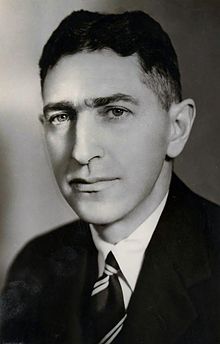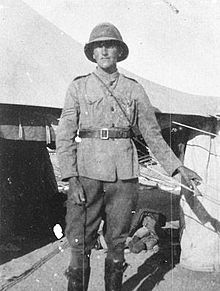Hudson Fysh
Sir Wilmot Hudson Fysh (born January 7, 1895 in Launceston , Tasmania , † April 6, 1974 in Sydney , New South Wales ) was an Australian aviation pioneer and businessman. He was honored as a soldier and pilot in World War I , was a co-founder of the Australian airline Qantas , sat on several national and international committees and wrote several books on the history of aviation in Australia , particularly that of Qantas.
youth
Hudson Fysh was the oldest of the five children of Frederick Wilmot Fysh and his wife Mary (née Reed). Known ancestors were his maternal grandfather, Henry Reed, a landowner and shipowner, and his great-uncle Sir Philip Oakley Fysh, two-time Prime Minister of Tasmania. His parents' marriage is described as broken, and Hudson kept running away from his father until he was allowed to stay with his mother in Launceston. Nevertheless, he is said to have had a happy childhood. After finishing school he began training as a farm worker and sheep breeder, which he broke off when the war broke out in 1914.
First World War
On August 25, 1914, Fysh volunteered in the cavalry. In the First World War he took part in the Battle of Gallipoli , and then fought in the Middle East in Palestine and Sinai. Promoted to lieutenant in January 1917 , Fysh served under Ross Macpherson Smith until he moved to the Australian Flying Corps and Fysh took his place. In July Fysh also applied for a move to the AFC and, after hard training, was appointed observer and gunner in October 1917. He fought against German and Turkish aircraft in the Middle East until 1918, under the command of Richard Williams . For a total of five kills, he received the Distinguished Flying Cross in January 1919 .
In March 1919, Fysh decided to take part in the Great Aviation Race from England to Australia together with his former pilot Lieutenant Paul McGinness: For the first successful flight England-Australia up to December 31, 1919, prize money of 10,000 Australian pounds was advertised. Australian philanthropist and politician Sir Samuel McCaughey volunteered to fund their business but died in July 1919 and McGinness and Fysh abandoned their venture. Instead, Fysh entered the service of the Australian government to prepare Northern Australia for the race. So there were no adequate runways there. Ross and Keith Smith , the race winners, were welcomed by Fysh as the Australian Department of Defense representative on December 10, 1919.
Founding and early years of Qantas
In Cloncurry , McGinness and Fysh began plans to provide an aviation service for charter flights and "air taxi". Since the financial means were insufficient, they began to advertise their idea, first winning over the rancher Fergus McMaster, and then his colleagues Alan Campbell and Ainslie Templeton for their idea. As early as June 1920 they formulated the registration of an airline company in Brisbane , which was founded on November 16, 1920 with a starting capital of 6700 Australian pounds (5360 pounds sterling ) as Queensland and Northern Territory Aerial Services (QANTAS).
Unlike other companies in the early Australian aviation history , QANTAS offered its services as an airmail company and charter aircraft and less for entertainment and show flights at the suggestion of McMaster. Another business area was the provision of the aircraft to doctors. Fysh advised the priest John Flynn , who became known as the founder of the Royal Flying Doctor Service . QANTAS was also supported by lobbying by North Australian regional politicians who demanded government support for scheduled flight routes. In 1922, Qantas successfully applied for the second Australian airline, which was to connect Charleville and Cloncurry . The hard-working Fysh continued his training to become a manager, became the company's Managing Director in 1923 and still flew as a regular pilot himself until 1930. On December 5, 1923, he married Elizabeth Dove, with whom he had a son and a daughter.
Rise of Qantas under Fysh
From 1931 to 1933 Fysh was involved in planning the airmail route to England, partly as a pilot. In 1934, QANTAS entered into a partnership with British Imperial Airways and now traded as Qantas Imperial Airways, with Fysh as managing director. In 1940 he was also a co-founder and board member of Tasman Empire Airways Ltd, the forerunner of what would later become Air New Zealand .
The internationally operating company was hit hard by the Second World War , and much of the equipment was requisitioned for military purposes . Still a reserve officer of the RAAF , Fysh coordinated supply and evacuation flights in action against the Japanese, especially in New Guinea .
In 1946 the Australian government acquired the former Imperial Airways' shares in Qantas, and in 1947 they bought Qantas at the market price. Hudson Fysh was the only board member to accept the sale to the government and even negotiate. As a result, he not only remained managing director, but also replaced McMaster as CEO. It was not until 1955 that Fysh retired from the position of managing director. The further relationship between the contentious entrepreneur and the board of directors was tense. In 1966 he finally resigned as chairman of the board and retired into private life. In 1974 he died in Paddington, a district of Sydney.
bibliography
Fysh published several books. In his first book he presented a biography of the first Qantas passenger, the then 87-year-old Alexander Kennedy. Most successful was his retired autobiography, in which he mainly describes the history of Qantas, and which was considered important by aviation historians. The hobby angler also wrote an essay on trout fishing.
- Taming the North (1933)
- The Log of the Astraea (1933)
- Qantas Rising (1965) - Autobiography Part 1
- Qantas at War (1968) - Autobiography Part 2
- Round the Bend in the Stream (1968)
- Wings to the World (1970) - Autobiography Part 3
- Henry Reed: Van Diemen's Land Pioneer (1973)
Committee and association work
Fysh was a member of various associations: he was a founding member of the IATA (since 1945) and its president in 1961. He was also a member of the Early Birds Society (an association of Australian aviation pioneers), the Australian Travel Association (then: Australian National Travel Association, now: Tourism Australia) and the Australasian Pioneer Club. After all, he was a "fellow" of the Royal Aeronautical Society and the British Interplanetary Society.
Honors
Fysh was knighted in 1953 (Knight Commander of the Order of the British Empire ) and was henceforth allowed to call himself Sir Fysh. In 1971 he received an honorary doctorate as an engineer.
He was posthumously listed in the 2001 list of the 100 Most Influential Australians of the 20th Century, published by The Sydney Morning Herald . In 2008 a Qantas Airbus A380 was named after him.
References
- ↑ Biography of the Qantas Founding Museum ( Memento of the original from September 12, 2009 in the Internet Archive ) Info: The archive link has been inserted automatically and has not yet been checked. Please check the original and archive link according to the instructions and then remove this notice.
- ^ Robin Higham: Book Reviews. Technology and Culture. Volume 7, 1966, pp. 560f / Volume 10, 1969, pp. 119f.
Web links
| personal data | |
|---|---|
| SURNAME | Fysh, Hudson |
| ALTERNATIVE NAMES | Fysh, Wilmot Hudson (full name) |
| BRIEF DESCRIPTION | Australian aviation pioneer and businessman |
| DATE OF BIRTH | January 7, 1895 |
| PLACE OF BIRTH | Launceston , Tasmania |
| DATE OF DEATH | April 6, 1974 |
| Place of death | Sydney , New South Wales |


